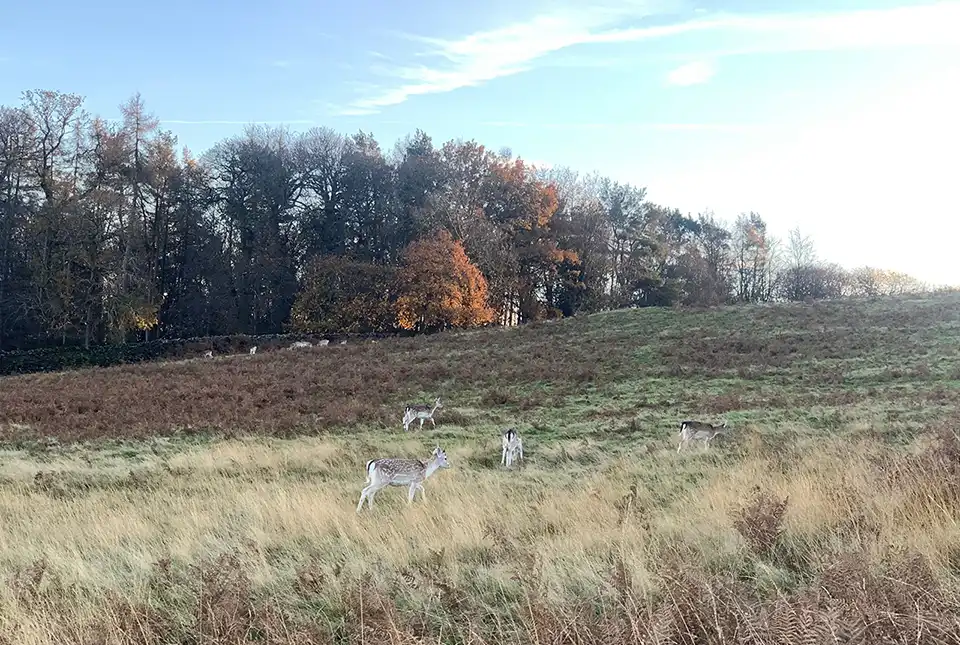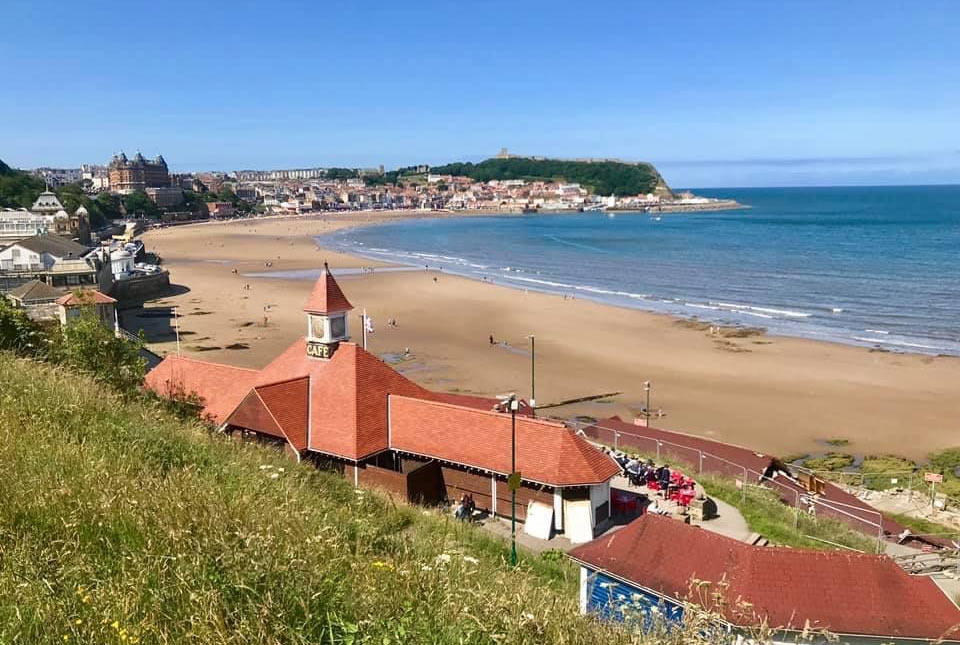Bradgate Park is a large, public park located between Leicester and Loughborough in the Charnwood Forest area. The park is renowned for its Precambrian volcanic rocks and its remarkable fossils. It was once believed that there were no fossils older than the Cambrian Period (541 to 485 million years ago), but the discovery of the fossil Charnia in these Precambrian rocks made the area famous for changing our understanding of early life on Earth.

The ash from the volcanoes in the area would have settled under water to create layered deposits. This outcrop is on the same hill as Old John Tower. BGS © UKRI.
Geology
The geology of Bradgate Park fits within the wider geology of Charnwood Forest, which contains some of the oldest rocks in England, dating back to the Precambrian (more than 541 million years ago). When the rocks of Bradgate Park were forming, England was mostly under water and was located close to the southern tropics, just off the margin of the Gondwana supercontinent, where there was active tectonism at the time.
The tectonism led to volcanic activity, creating the various rock types we see in Bradgate today, such as intrusive diorite, as well as sedimentary deposits that contain volcanic material.
Within and around Bradgate Park, the oldest geological unit — the Beacon Hill Formation — appears as the crags around the hill crowned by Old John Tower. Overlying the Precambrian rocks is a younger sequence from the Triassic Period (which is still pretty old at 247 million years!) that consists of red and silty mudstone called the Mercia Mudstone Group. However, these rocks can be hard to see around the park as much of the mudstone is covered by grass, with just a few outcrops visible near the river south of Bradgate House. The red bricks of Bradgate House are said to have been made from these Mercia Mudstone Group rocks.
The most recent deposits in Bradgate Park are from the last ice age, when the sediments were carried by glaciers from northern Britain. These were deposited in the area when the glacier melted and retreated to the north, around 10 000 years ago.
Fossils
In addition to having some of the oldest rocks in England, Bradgate Park is also known for some of the oldest fossils on Earth: Charnia. Charnia lived about 635 to 538.8 million years ago, which dates back to the Ediacaran period, and are some of the earliest known examples of multicellular organisms. They represent a unique and important part of the history of life on Earth.
Fossils of the species C. masoni were discovered in the eastern part of Charnwood Forest in 1957 and were the first macrofossil to be found anywhere in the world known to be Precambrian in age. The fossils were formed when these moderately soft-bodied organisms came to rest on the bottom of the ocean and were rapidly buried, pressing them down into the sediment. This created impressions that are typically 1 mm or less in height, meaning they are often difficult to spot and can only be seen when the sun is low in the sky during the autumn months. However, Charnia fossil imprints are displayed and available to view at the Charnwood Museum in Loughborough.

Fossil imprint of Charnia grandis in the Ediacaran rocks of Bradgate Park. C. grandis is the frond-like imprint at the top of the image. BGS © UKRI.

Reconstruction of C. masoni by Matteo De Stefano/MUSE. This file is licensed under the Creative Commons Attribution-Share Alike 3.0 Unported license.
Bradgate Park
Aside from the fascinating geology, Bradgate is also known for its large herds of red and fallow deer that are free to roam the park and often easily spotted from the footpaths. The site has been used as a deer park since the medieval period and it is now home to around 550 animals. Bradgate also has several interesting structures including the ruins of Bradgate House, one of the earliest brick buildings in the country and a Grade II listed building.

Free-roaming fallow deer in Bradgate Park. BGS © UKRI.
The house was the ancestral home and birthplace of Lady Jane Grey, who was Queen of England for nine days in 1553 before she was overthrown and later executed by her cousin, Queen Mary I. Construction on the house started in 1499 and was completed by 1520 but the house was abandoned by 1739 and had fallen into ruin by 1790.
The site is now looked after by the Bradgate Park Trust and the remnants of the house are nestled within the heart of the park. In the north-west corner, on the tallest hill in the park (and the second highest point in Leicestershire), sits the Old John Tower, an 18th century folly that has been dubbed the ‘icon of Leicestershire’ for its prominent presence and appearance.

Old John Tower in the north-west corner of Bradgate Park, Leicester. BGS © UKRI.
The tower was built from local granite in 1784 to replace an old, dilapidated windmill and was used as a viewing platform for horse racing and fox hunts on the estate by the 5th Earl of Stamford. On the hill adjacent to the Old John Tower stands the Yeomanry War Memorial. Erected on consecrated ground, the obelisk was built in 1924 and is dedicated to the Leicestershire Yeomanry field regiments that fought and died in the Boer War and the First and Second World Wars. Heading up the hill to the folly and war memorial offers walkers beautiful views across the park and the surrounding countryside.
Advice
Bradgate Park is a deer park, which means the deer are allowed to roam freely in certain parts of the park. There is a map at every entrance to show these areas. If you bring a dog, it must be on a lead in these sections of the park both for the safety of the deer and for your dog, as well as for the other visitors. This is especially important in spring when there are new fawns, as the deer are very protective of them.
Bradgate Park is a large, exposed hill with very little tree cover, so it is common for it to be windy and there is little shelter if it rains — do bring an extra layer for warmth as the weather can turn quickly. Boots are recommended as some of the trails have jagged rocks sticking out of the ground and some of the hillsides can be quite steep.
Getting there
The park is located close to the M1 and several junctions between Leicester and Loughborough can be taken to get there. There are two car parks on the northern side of Bradgate Park and another to the south of the park if arriving through Newton Linford. The only public transport is the 125 bus, which travels between Castle Donington, Coalville and Leicester.
- The Bradgate Park Trust
- Historic England: Bradgate house, chapel, garden and watermill
- BGS guide to the geology of Bradgate Park and Swithland Wood, Charnwood Forest (British Geological Survey Occasional Report 0R/10/04)
- Charnwood Museum, Loughborough: Permanent dDisplays | Charnwood Museum
- Geological timechart – British Geological Survey (bgs.ac.uk)
About the authors

Dr Charlotte Hipkiss
Stable isotope research assistant

Kotryna Savickaite
Geochemistry technician
Relative topics
You may also be interested in

Discovering Geology
Discovering Geology introduces a range of geoscience topics to school-age students and learners of all ages.

Maps and resources
Download and print free educational resources.

Postcard geology
Find out more about sites of geological interest around the UK, as described by BGS staff.



